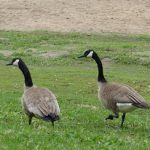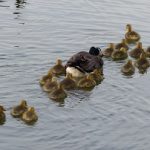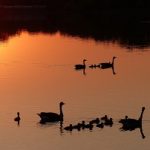Rich made a New Year’s resolution to walk around Cedar Lake at least 100 times in 2017 after making over 90 lake circuits last year. The 60-acre lake is near downtown Cedar Rapids, Iowa, and features a 1.7 mile long paved trail following its shore. Every day pedestrians and bicyclists share the trail with Canada Geese.
“Lake circuits are always interesting, and many migrating water and shore birds visit Cedar Lake, but I especially like watching changes in goose behavior as the months go by,” Rich said.
Many people hate Canada Geese, mostly because of the mess they leave on the trail and lawns. But geese are fascinating animals. Closely observing them gives insights into their rhythm of life.
Geese live a long time. A quarter century is possible, which is a much longer lifespan than enjoyed by most wild animals. They pair up when young and mate for life. When a mate dies, the survivor often re-mates. Geese seem to enjoy plenty of leisure and like to socialize, and few predators bother them.
All winter they mingle in large flocks that are mostly big family groups of goose couples and their offspring. However, by early March the groups split up and human walkers around the Lake see mostly goose couples. They loiter near the trail, swim a bit, and forage on grass and grain spilled from nearby rail cars. In very early spring the female makes a simple nest on the ground. It’s hidden but if you see a goose pair in March their nest is likely close by.
Every day or two the female visits her nest and lays an egg before joining her mate for a day of foraging. Once the clutch of four to a dozen eggs is complete, she’ll begin a five-week incubation. During this time trail walkers only see single geese, and that’s likely the gander. He’s keeping a close eye on the hidden nest and his patient mate sitting on her eggs. Approach the nest and he will try to drive you away.
By the end of April, give or take a couple of weeks, the eggs hatch and for the next few months the parents protect and teach their youngsters. Baby geese, or goslings, grow fast and by late summer are full size and look just like their parents. For the next six or seven months they’ll stay with their family until it’s time to form pairs and begin the nesting process next spring.
Canada Geese are abundant and few urban wildlife sights are as pleasing to us as a flock winging over downtown at sunset.
- Geese pair up in the spring
- Photo – Protective custody
- At sunset




